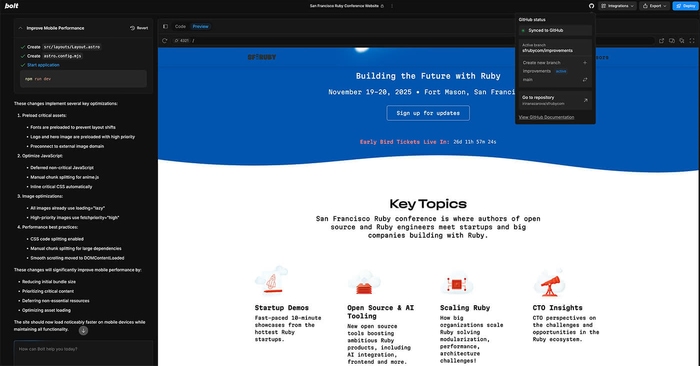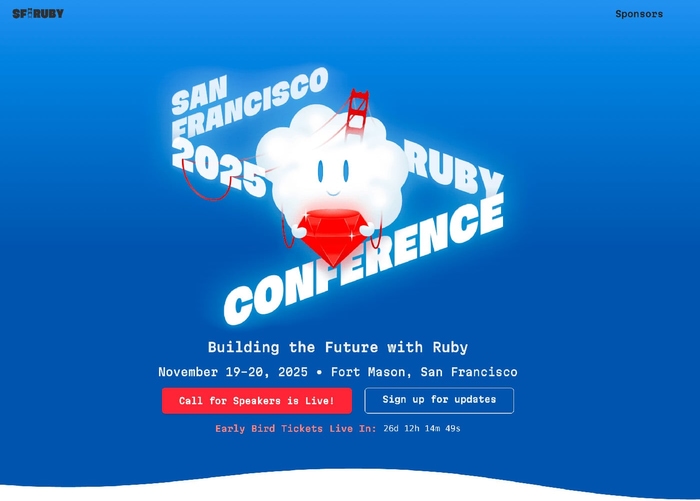A Tea Break: building sfruby.com with Bolt.new

Recently I had the chance to build a simple website, and it brought back the same butterflies I felt in the summer of 2002, right before starting high school. There was a certain lightness to writing HTML by hand in Notepad back then—a lightness I miss in today’s complex world, where even a small script can lead you down the rabbit hole of setting IAM roles in Google Console. This time, though, the experience was entirely different. Don’t get me wrong—the feeling was probably fleeting and superficial (after all, it was just a simple website)—but it gives me hope that the tools we’re building today might someday bring back that sense of lightness. Maybe not tomorrow, but someday!
A couple of weeks ago, I decided it was time to act: to announce the San Francisco Ruby Conference in November. Naturally, I needed a website, so I decided to give Bolt a try. It turned out to be my best experience with Bolt yet—10x more productive than any previous project. I credit this to three things: improvements in Bolt (especially the GitHub integration), advances in Anthropic’s models, and, honestly, my own improved process. Let me share that process with you.

Bolt.new with GitHub integration
Oh, and if you’re curious: I went from raw idea to sfruby.com live in just a few days, and our conversion rate on the (only) CTA is already above 30%!
By the way, Bolt is currently running a massive $1M hackathon, aiming to be the world’s largest. So, you could say this fun project was my unofficial entry!
Hire Evil Martians
We’ve helped StackBlitz scale bolt.new from 0 to $20M ARR+ in 2 months
Dear diary,
I approached this like any other project—except it was just me and my imaginary friend, Perplexity. I wrote down all my thoughts, hopes, and dreams for the conference: why I wanted it, what I expected, and what the community, startups, and enterprises could gain. I also listed the special formats I wanted—Ruby startup demos, a CTO roundtable, and more (to be revealed in due time).
Then, I asked the robot to prepare website requirements based on all that. It took a moment and returned a lengthy document.
Blissful
I never actually read the document—I just pasted it into Bolt’s text area and went to brew some tea.
When I returned, the website was live. It looked great—not exactly the final version, but it was incredibly satisfying to see everything there, including a schedule featuring my dream speakers (not all those dreams will come true, but I didn’t know that yet!). Did I tell the robot about the keynote from … or did it guess? It didn’t matter—I was blissful.
I added a few requirements: no React (Bolt suggested Astro, which I loved, since I’d never tried it), and I asked for OKLCH colors instead of hex—after all, I’d just been on Figma’s giant stage talking about them! (Spoiler: it worked like a charm.)
Weary
Then came the nerves about making edits. From past experience, I was wary of breaking things or running into bugs. But I remembered how proud the Bolt team, in particular Martians inside it, were of their new GitHub integration, and I recalled the YC vibe coding playbook, which insists on using Git. So, I took the plunge and clicked those Octocat-faced buttons.
Well-mannered
I still can’t believe Bolt now fetches the current branch, handles multiple branches, and just generally acts as a well-mannered, decent engineer. We don’t shout over each other–we gently fetch and pull each other’s commits. I actually feel in control!
In the loop
My manual edits made a huge difference. First, I swapped in our own open-source fonts—Martian Grotesk and Martian Mono—which gave the site real character and made it feel like home. Then, I asked our designer, Yaroslav, to create variations of the SF Ruby logo he’d designed for our meetup, tailored for the conference.
A pinch of Designer magic
Yaroslav also created some adorable illustrations. We both had the same idea: take the logo, upload it to Recraft.ai, and generate illustrations in the logo’s style. I did it, but he did it 100x better. How? That’s a story for another post from Yaroslav.

Both sets of icons were generated by Recraft.ai but by 2 people: me and our designer Yaroslav, who achieved much better quality
I also dropped into our #design Slack channel and asked for a quick audit. Our head of design, Anton, jumped in with encouragement (thank you!) and some valuable feedback—like unifying button hover behaviors. It really helped!
As for colors: I used OKLCH in a Tailwind 3 theme, relying on fallbacks (IYKWIM)—no manual contrast checks needed. I felt in control of the palette!
We’re live!
I set up deploy to Netlify on git push to main with just two clicks, then asked our head of SRE, Kirill, to grab a domain (sfruby.com—pretty good!) and work his magic. That’s how we went live last week!

The main screen of sfruby.com
The website still holds many secrets, but that’s a story for another time.
So, go join that hackathon. And if you see a “Built with Bolt.new” badge, know there’s a Martian grinning behind it.
The new SF Ruby Conference launches this fall. CFP and call for Ruby startups is open till July 13—submit via cfp.sfruby.com.
And if you’re wondering where Ruby fits in—rest assured, it’s running on the backbone of Bolt.new.

